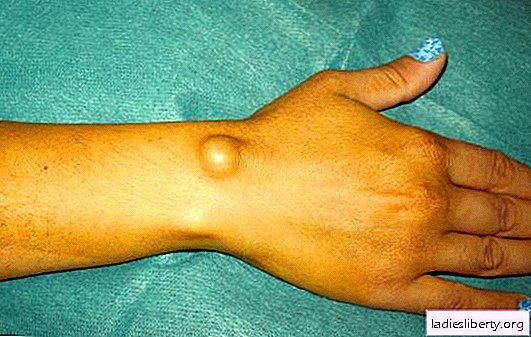
The inflammatory process in the lymph nodes, as a protective reaction to the introduction of infection into the body - lymphadenitis - happens in both children and adults with a variety of pathologies. All groups of regional lymph nodes increase, or, depending on the pathology, a change occurs in the lymph nodes of a certain location.
Lymph nodes are a barrier to the further spread of infection. Inflammation can be caused not only by bacteria, viruses, fungi, but also toxins with tissue breakdown products - any foreign protein that enters the body is delayed by the lymph nodes.
Most often, lymphadenitis occurs in children aged one to six, is secondary (cases of isolated primary inflammation of the lymph nodes are extremely rare).
The state of lymph nodes in healthy children
Normally, the size of the lymph nodes is up to 1.0 cm, but they can vary in a healthy child - from 1.5 to 2.0 cm. An increase of more than 2.0 cm, as a rule, is already a symptom of some disease, but all this is individual and evaluated in conjunction with other features.
When palpation in a healthy child, the lymph nodes may not be palpable, or smooth, painless, elastic individual groups of lymph nodes are palpated:
• cervical;
• axillary;
• inguinal.
Growth and development of the lymphatic system, incl. and lymph nodes, the child ends at the age of six. Therefore, the entire period of formation is accompanied by increased susceptibility to even the smallest disorders in the body.
Lymphadenitis in children - causes
Enlarged and inflamed lymph nodes are the result of infection by hematogenous, lymphogenous, or contact routes.
The most common cause of lymphadenitis in children is nonspecific infection caused by staphylococci and streptococci.
The causative agents of lymphadenitis are bacteria, viruses, fungi, protozoal infection.
Lymphadenitis can be:
• local;
• regional;
• generalized.
Regional lymphadenitis develops with streptococcal, staphylococcal infection, tularemia, tuberculosis, syphilis, and genital gerpes.
Generalized lymphadenitis occurs with infectious mononucleosis, cytomegalovirus infection, toxoplasmosis, tuberculosis, AIDS, etc.
This can be the pathology of any organs and systems: ENT, respiratory, musculoskeletal, genitourinary, digestive organs (inflammation in the oral cavity).
In addition to the above, with lymphadenitis in children, the causes may be associated with other existing diseases or conditions. These include:
• allergic manifestations as a result of vaccination or helminthiasis;
• blood diseases;
• oncopathology with the presence of metastases;
• autoimmune diseases;
• long-term use of certain medications;
• violation of metabolic processes.
Lymphadenitis in children - the first symptoms
The clinic of lymphadenitis in children manifests itself more rapidly than in adults. Distinguish:
1. Acute lymphadenitis, which is characterized by:
• short latent period;
• raising the temperature to high numbers;
• painful palpation;
• localization of the process in the lymph node, does not go beyond the capsule.
2. Chronic lymphadenitis is different from acute:
• duration;
• painlessness.
With lymphadenitis in children, the first symptoms are the same and are characterized by:
• pain;
• increase in size;
• high temperature.
With the progression of the process, skin hyperemia may occur.
For the convenience of assessing the inflammatory response from the lymph nodes, three degrees of their increase are identified:
I degree - 0.5 - 1.5 cm in diameter;
II degree - 1.5 - 2.5 cm;
III degree - 2.5 - 3.5 cm in diameter and more.
Lymphadenitis in children - signs
With lymphadenitis in children, the symptoms can be varied, because it is a manifestation of a disease. Therefore, symptoms of the underlying disease that caused lymphadenitis come first. Enlarged lymph nodes accompany infectious diseases that occur in children more often than other pathologies, therefore, with lymphadenitis in children, the first symptoms may be manifestations of the underlying disease.
Basically, these are signs of intoxication:
• lethargy, weakness;
• headaches;
• reduced appetite;
• chills;
• skin itch;
• impaired consciousness and other signs of pathology that caused lifadenitis are possible.
Depending on the localization of the pathological process in children, there is an increase and inflammation of certain groups of lymph nodes
1. Most often, enlarged inflamed lymph nodes on the neck of the child become noticeable. As a rule, lymphadenitis of the upper cervical lymph nodes is determined, this indicates the infectious nature of the disease.
With left supraclavicular lymphadenitis in children, signs of intoxication with severe weakness, sweating, fatigue, and lack of appetite may indicate a tumor process in the abdominal cavity.
The supraclavicular lymphadenitis on the right accompanies a lesion of the chest organs.
It can be:
• tuberculosis;
• sarcoidosis;
• lymphoproliferative diseases.
In these cases, mediastinal lymphadenitis is also found.
2. The following pathologies lead to axillary lymphadenitis:
• cat scratch disease;
• infections of the upper limbs, chest;
• cancerous tumors.
3. Inguinal lymphadenitis is a manifestation of infections of the inguinal region and lower extremities.
4. Occipital lymphadenitis cause:
• rubella;
• infections on the head.
5. The parotid is a manifestation of:
• cat scratch disease;
• eye infections.
With lymphadenitis caused by an acute bacterial infection, the following occurs:
• unilateral defeat;
• pain on palpation;
• fluctuation;
• redness of the skin over the affected lymph nodes.
With the oncological process, dense, painless lymph nodes are determined.
The problem of lymphadenitis in children is currently relevant and difficult for doctors of various specialties. Most cases of inflammation and enlarged lymph nodes are associated with the presence of benign processes. But often a high probability of a tumor is detected, and then the child needs an urgent oncologist consultation to resolve the issue of early treatment.
Lymphadenitis in children - treatment
With lymphadenitis in children, treatment begins after a thorough examination, clarification of the etiological factor that caused the underlying disease and inflammation of the lymph nodes.
1. For treatment, etiotropic drugs with high efficiency and safety are used. If it is clear that lymphadenitis is a manifestation of an infection, the following are prescribed:
• macrolides,
• aminopenicillins;
• cephalosporins;
• antiviral;
• immunomodulatory drugs.
The principle of treatment of lymphadenitis in children is the early appointment of antibacterial drugs, until the results of the tests are obtained, if there are pronounced changes in the oropharynx and lungs, or the child’s condition is serious.
After 5 - 7 days, when the pathogen is precisely determined, treatment continues with macrolides or antiviral drugs / Acyclovir, Arbidol /).
In mild or moderate conditions, the drugs of choice from the first days are macrolides. The average course of treatment is 10 days.
2. Antiviral drugs are prescribed if the child has lymphadenitis and herpes viruses. They are applied simultaneously.
3. The complex therapy includes immunomodulators:
• Lycopid;
• Cycloferon;
• Viferon.
The success of treatment depends on the early appointment of complex therapy, including the listed groups of drugs.
Lymphadenitis in children - prevention
With lymphadenitis in children, prevention is aimed at timely diagnosis and treatment of diseases in order to stop the spread of the process and prevent complications.
It is necessary:
• as much as possible to avoid injuries in the child;
• take measures to prevent the spread of infection, if the child has abrasions or scratches - treat with antiseptics in a timely manner (hydrogen peroxide, "greenback", iodine should always be at hand), protect with special antibacterial plasters;
• pay attention to the condition of the oral cavity and teeth: treat caries on time, monitor the daily hygiene measures of the oral cavity;
• maintain high immunity: conduct multivitamin courses with mineral supplements, hardening; exercise, walks in the fresh air.
Attentiveness to the health of the child, the implementation of all hygienic and preventive rules will protect the child from illness.











